 |  |  |
 |  |  |
 |  |  |
Festivals and Events |
| Date & Time | Name | District |
|---|---|---|
| mid-April | Nagiso Mitsuba-tsutsuji Festival | Midono |
| May 5 | Hakusan Shrine Festival (spring) | Yogawa |
| 1st Sun of June | Nagiso & Tsumago Health Marathon Meet | Tsumago |
| July, weekend preceding Marine Day | Higashiyama Shrine Festival | Midono |
| July 23 - 24 | Wachino Shrine Festival | Tsumago |
| 4th Sat of August | Tsumago Post Town Fire Festival | Tsumago |
| Chushu no Meigetsu (Harvest Moon) | Yogawa Autumn Moon Viewing Party | Yogawa |
| 1st Sun of October | Hanauma Festival | Tadachi |
| 3rd Sun of October | Hakusan Shrine Festival (autumn) | Yogawa |
| 1st Sat and Sun of November | Arts and Crafts Trail Festival | Hirose, Araragi |
| November 23 (Labor Thanksgiving Day) | Bunka-Bunsei Customs Parade | Tsumago |
Hakusan Shrine Festival |
After the shinto ritual takes place within the shrine grounds at 1:00 p.m., a female shishi (Japanese lion) dance to drive away evil spirits, which is said that locals of Hakusan, Ishikawa, passed along during the Kansei era about 190 years ago, is dedicated to the enshrined god. The large lion’s head (full length is about 60 cm) is carved solely out of hinoki cypress wood. After the dance, mochi rice cakes are thrown in another traditional ceremony to end the festival. Local rice wine called “Somazake” is served as sacred sake. |
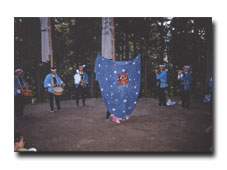 |
Higashiyama Shrine Festival |
This festival is held every July on the weekend before Marine Day for a minor deity of the Midono district. Guardian parade around Midono while singing songs and carrying a portable shrine. Infants experiencing the festival for the first time are held by the guardians and walk under the portable shrine to pray for their healthy growth. |
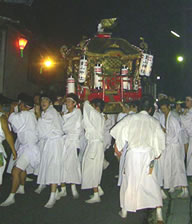 Higashiyama Shrine’s Portable Shrine |
Portable Shrine Song
|
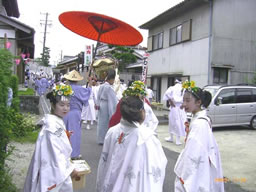 Primary school girls act as shrine maidens and follow behind the portable shrine. |
| Photo Credit: Wataru Honda |
Wachino Shrine Festival |
Festival for the local deity of Tsumago Post Town. Local people acting as shrine guardians parade a portable shrine around the post town while shouting “Genimosayona”. |
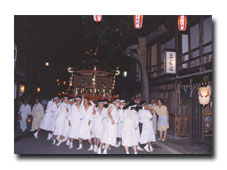 A portable shrine is paraded through the streets of Terashita. |
Tsumago Post Town Fire Festival |
An annual festival held on the 4th Saturday of august. |
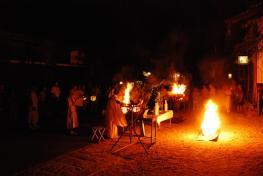 |
Yogawa Autumn Moon Viewing Party |
Held at the time of the harvest moon at the site of the Koten-an Ruins. Moonrise occurs at a different time each year, between 6:00 and 6:50 p.m. |
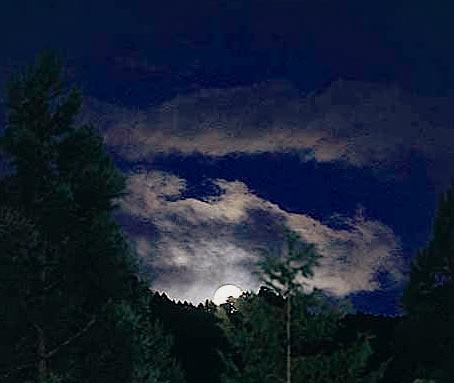 |
Hanauma Festival |
This vibrant festival is held to give thanks for a bountiful harvest. Three Kiso horses, with saddles adorned by colorful flowers (crafted from thin strips of bamboo and colored paper), depart from Tadachi Station at 12:30 p.m. They are led to the Itsumiya Shrine in a slow procession, accompanied by music from flutes and drums. After the procession has circled the shrine grounds three times, the waiting people jostle to grab on of the flowers from the horse’s backs. The paper blossoms, shaped like ears of rice, are said to ward off evil spirits when placed at the entrance of a house, or to repel insects from growing rice when placed on the ridges between rice fields. In 1993, the festival was designated as an Intangible Cultural Property for Nagano Prefecture. These decorated horses also participated in the closing ceremony of the Nagano Winter Olympics. * There is are no parking areas in the vicinity, so please use public transport when attending this festival. |
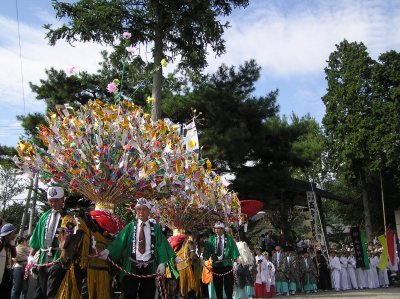 |
| Date |
|---|
| 1st Sun of October |
| Schedule |
| Children’s portable shrine Flower Horses depart Tadachi Station 12:30 p.m. Arrive at Itsumiya Shrine - 3 circuits of the shrine rounds - Children’s portable shrine - Rice-cake throwing Festival ends 2:30 p.m. |
| Tadachi District Culture Festival (Gymnasium of the former Tadachi Elementary School) |
| First Saturday in October (the day before the Hanauma Festival) (Tadachi Kabuki is the opening performance) |
A performance of Tadachi Kabuki is held on the eve of the Hanauma festival. This ancient style of Kabuki theatre premiered in 1729, during the Edo Period and has been passed down from generation to generation through ancient documents. Kabuki’s popularity in Edo (Tokyo) was soon transmitted to the Kiso Valley as the favorite entertainment for the people of that time. This locally performed variant has been carefully protected to keep its ancient style distinct from the central school of Kabuki performance. In 1954, it was designated as an Intangible Cultural Asset of the town, and the younger generation of the preservation society are committed to refining the art. |
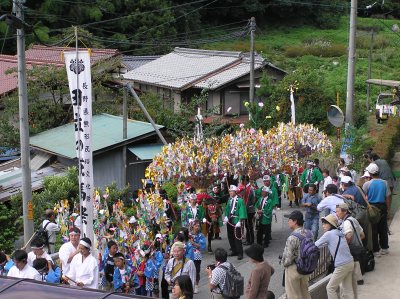 |
Arts and Crafts Trail Festival |
In November, the various craft shops spread along Route 256 participate in demonstrations of their craftsmanship and discounted sales of works such as traditional woodwork and hinokigasa (cypress weaved hats). There are a lot of corresponding promotions, including discounted hot spring bathing, and free sake & oden. Won’t you spend an autumn day experiencing Nagiso’s traditional craftsmanship? |
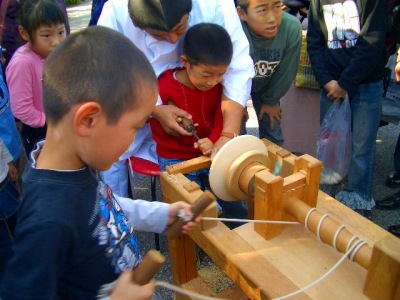 |
| ||||||||||||
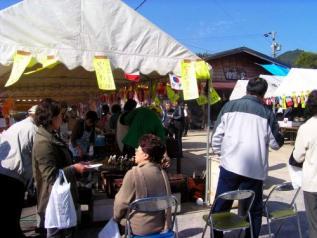 |
Bunka-Bunsei Customs Parade |
This parade is held annually on Labor Thanksgiving Day (November 23) to celebrate the anniversary of the Tsumago Post Town Preservation Project that was established in 1968. About 130 local residents dress in traditional costumes including samurai, ronin, bird scarers, pilgrims, couriers, mendicant monks, and reenact the customs of the Bunka and Bunsei eras. On the day of the event, the procession departs the Nagiso Sogo Ground, 2 km to the north of the town, at around 10:30 a.m., travelling along the ancient Nakasendo Road to reach the center of the post town at around noon. The procession sings a traditional song and surrounds a bride carried on a Kiso horse, a matchmaker, and children carried on traditional shoulder-born palanquins. It is a popular subject for photographers. |
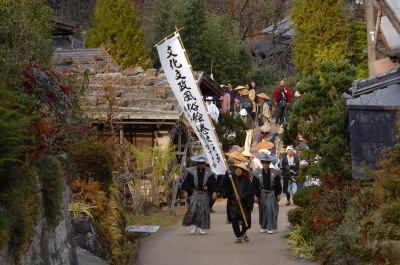 |
At lunchtime, the people sit in traditional wood-floored terraces that line the highway (known as “Dei” in the Tsumago district’s dialect) to enjoy meals such as bento (box lunches) or rice wrapped in bamboo leaves, while some smoke traditional metal tipped pipes, recreating the atmosphere of the Edo era townscape. After lunch, the procession continues at a leisurely pace to its end, O-tsumago district, and then returns to the center of Tsumago Post Town. At this, the people enjoy traditional drum performances, taking commemorative photographs, and throwing harvest-celebration rice cakes in the grounds of the former Tsumago Elementary School. |
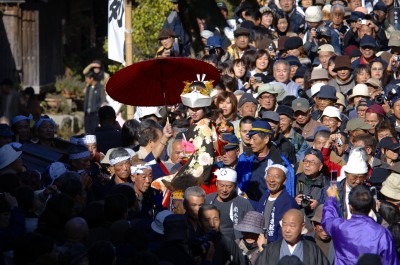 |
Tsumago Post Town Appreciation Society, Bunka-Bunsei Customs Parade Organizing Committee
Tel: 0264-57-3513
Nagiso Town Office, Tourist Industry Division, Office of Commerce & Tourism
3668-1 Yomikaki, Nagiso, Kiso-gun, Nagano, 399-5301
TEL 0264-57-2001 FAX 57-2270
| 10:00 | The cast meet at Oshima District (1) Nagiso Town Sogo Ground |
| 10:30 | The parade departs (signaled by fireworks) |
| 11:00 | Break time (2) Tsumago Castle Ruins Trailhead |
| 11:20 | Merging with the bridal procession (3) Oya-mae |
| 12:00 | Parade arrives at the post town (4) Terashita District |
| ~12:40 | Lunch, Terashita District |
| 12:50 | The parade departs (signaled by fireworks) |
| Around 1:20 p.m. | Parade arrives & break time (5) O-tsumago District → Transport to the Town-run Parking Lot No. 3 by bus. |
| 13:50 | From the Parking Lot No. 3 through Terashita to (6) the Former Tsumago Elementary School Grounds |
| From around 2:15 p.m. | Drum Performance, Vegetable Offering Auction, Commemorative Photographs, Harvest-Celebration Rice Cakes at Former Tsumago Elementary School |
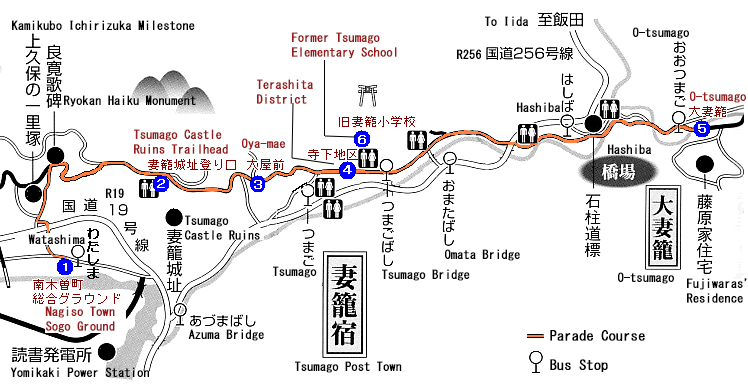
| Link Guidelines | Privacy Policy | Sitemap |
| Nagiso Town Tourism Association |
Copyright1997 Nagiso Town. |